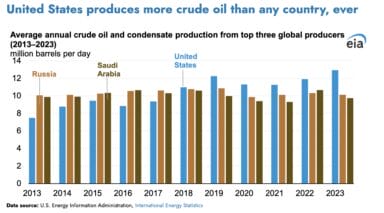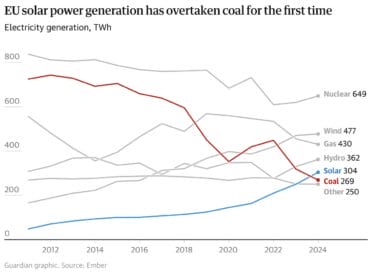Sign up for the Climate Power & Progress newsletter.
Our 2024 Climate on the Ballot newsletter highlighted the role of climate change on nearly every election issue, from the border to inflation to women’s rights. This year, we’ll analyze how those elected leaders are impacting global climate action, and the economic and societal power dynamics at play. How does power impede and propel progress? How do movements for progress build and use power? Vea la versión en español de Poder y Progreso.
Trump’s Retrograde Energy Agenda
President Donald Trump doubled down on fossil fuels as his energy choice for the future in a series of executive orders that he signed on his first day. In addition to declaring a “national energy emergency,” he:
- Withdrew the US from the Paris Agreement
- Rolled back restrictions on drilling in Alaska
- Rolled back a raft of environmental protections
- Paused all federal permitting for wind power projects
- Stopped billions of dollars of payments already appropriated for climate-related Inflation Reduction Act and Infrastructure Investment and Jobs Act projects for 90 days
These moves scrap some policies the Biden administration put in place to accelerate the US transition to renewable energy and loosen regulations on fossil fuels. The emergency declaration grants the president additional powers under the 1976 National Emergencies Act (NEA). It’s not yet clear which powers he intends to use — the order was short on specifics — but experts project he’ll suspend environmental protections; weaken, roll back, or not enforce regulations; and speed up permitting for pipelines, transmission lines, power plants, LNG terminals, and mining projects.
We’re likely to see a profusion of court cases once he begins using expanded powers. “It will take a considerable amount of time for most of those initiatives to come to fruition, and they will then face judicial scrutiny,” notes Dan Farber, co-director at UC-Berkeley’s Center for Law, Energy & the Environment.
THE POWER
The US does not have an energy shortage; President Trump’s claim otherwise is false. The US is the world’s top producer of oil (since 2013) and natural gas (since 2009).

As much as President Trump likes to say “Drill, Baby Drill,” the truth is that oil and gas companies are far less interested in drilling than they are in prolonging demand for their products in a world that is rapidly transitioning to renewable energy. Oil and gas execs are pushing for policies that will help them “lock in use of their products for years to come,” The Wall Street Journal reports, including several addressed in Trump’s orders:
- Easing permitting rules for pipelines and LNG terminals to export fossil fuels to new markets.
- Rolling back Biden’s electric car incentives and tail pipe rules to delay EV adoption in the US.
- Rolling back Biden’s methane rules requiring companies to pay fees on emissions that exceeded limits set in the Inflation Reduction Act.
- Relaxing the Environmental Protection Agency’s oversight and enforcement mechanisms, including revisiting the Obama-era endangerment finding that determined carbon dioxide and methane threaten human health and must be regulated.
Tech CEOs are also making energy their business. There are now over 5,000 data centers in the US, with new ones being built every day around the world, according to MIT News. They require a staggering amount of energy. In the US alone, data centers could soon grow to use more electricity than some cities, and even entire states.
THE PROGRESS
Trump’s national energy emergency declaration purports to create a “reliable, diversified, and affordable supply of energy,” but his orders are at odds with all of those goals.
Reliability. Improving battery storage and modernizing the grid infrastructure make it possible to store and transport solar and wind energy for later use. While oil and gas are finite resources, the sun and wind are not.
Diversified Sources. Reporters at the New York Times noted that solar power, wind, and battery storage were not included in the “energy resources” listed in the declaration, while crude oil, coal, gas, and a laundry list of other fuels (including “the kinetic movement of flowing water”) were.
Affordability. Solar and wind power have “lower operating costs than fossil fuel alternatives” and their costs continue to rapidly fall, reports the International Energy Association. Four years ago, solar power emerged as the “cheapest electricity in history,” and E&E News reports that analysts say that solar may be “too big to fail,” even if Trump cuts IRA subsidies.
Story Ideas
- What’s the real emergency? Increasing fossil fuel use and greenhouse gas emissions will only intensify climate change–fueled extreme weather events like the Los Angeles wildfires. “There is no energy emergency,” Manish Bapna, president and CEO of the Natural Resources Defense Council, said in a statement. “There is a climate emergency.”
- AI and energy. Earlier this month, President Joe Biden signed an executive order aimed at accelerating the growth of US AI infrastructure using clean energy sources, including nuclear power, to fuel them. Trump rescinded that executive order. Are tech corporations like Amazon, Google, Meta, Microsoft, and others backtracking on net-zero pledges since Trump was re-elected?
- LNG Terminals. In the “Unleashing American Energy” EO, Trump lifted the pause on liquified natural gas terminals and plans to speed up permitting for the dozen or so proposed projects halted by the Biden administration. Safety standards that haven’t been updated since the Carter administration jeopardize the health and safety of nearby communities, E&E News reports. Attempts to modernize them slowed during the last Trump administration.
- The EPA’s “Endangerment Finding.” The president ordered a review of the EPA’s 2009 finding that greenhouse gases are a danger to human health and the environment. Revoking it would undermine the EPA’s authority to regulate emissions. Michael Gerrard, an environmental lawyer and director of the Sabin Center for Climate Change Law at Columbia Law School, told Mother Jones that would be a “fool’s errand”: “The amount of scientific evidence available when the Endangerment Finding was first made in 2009 was overwhelming. It’s now overwhelming-squared.”
- Report on Disinformation. Fossil fuel companies and their supporters have spent hundreds of millions of dollars to spread false claims and disinformation about renewable energy and electric vehicles on social media, some of which President Trump repeats. This report from Columbia University’s Sabin Center debunks 33 of the most pervasive false claims. Report on them to help audiences learn to spot lies.
PROGRESS CHART
“More electricity was made from sunshine than coal in the EU last year,” a new report reveals. In 2024, solar power generated 11% of the EU’s electricity, surpassing coal at 10%.

Support Covering Climate Now
We’re working to help journalists worldwide improve and expand their climate coverage. Meet our staff and learn more about CCNow.



